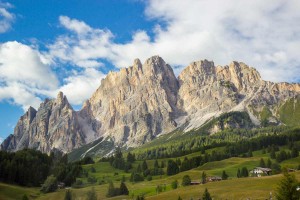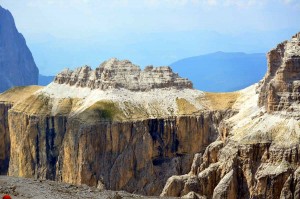
©Bigstock.com/tomtsya
Italy’s magnificent beauty is hard to put into adequate words. Cultural, artistic and architectural achievements aside, it is a stunning country of wide, impressive diversity from north to south. Imposing mountain ranges, wide valleys, magical rivers and glowing beaches are wonderfully fascinating to both locals and guests from all over the world. Some of those scenic beauties even achieved the status of UNESCO World Natural Heritage Site. The Dolomites with its nine areas and 18 peaks stretch across three regions and five provinces. Are you ready for an extended tour through the Southern Limestone Alps? Strap in!
Mountain landscapes of exceptional natural beauty

©Bigstock.com/inguaribile
The Natural Heritage committee used these flowery words to describe the truly unique region in Northern Italy with a core area of 141,910 hectares and just under another 90,000 buffer hectares. The Dolomites are most certainly deserving of protection – certainly not a revolutionary assessment as all nine areas had already achieved the status of either nature park, national park or Natura 2000 before the Natural Heritage declaration on 26 June 2009. The foundation Dolomites UNESCO manages all interests of the protected area.
Ultimately, not all recommended areas made it onto the illustrious UNESCO list – something you’re certainly already familiar with from other sites. The Langkopfel Group, Bosconero Group and Sella Group remain excluded, but efforts to change that are ongoing. For now, we take a look at the nine currently included areas across the regions Friuli-Venezia Giulia, Trentino-Alto Adige and Veneto.
Pelmo-Croda da Lago
Our tour starts in the heart of the region. The mountain system Pelmo-Croda da Lago in the Province of Belluno is dominated by Monte Pelmo (3,168 m). It is also known as “Caregon del Padreterno”, the “Throne of God”, due to its unusual shape. According to legend, God sat down on Monte Pelmo after having created the Dolomites to rest and admire his handiwork. Countless other peaks, such as Pelmetto at just below 3,000 m or the eponymous Croda da Lago (2,701 m), are also part of this impressive mountain range.
Marmolada
Are you ready to meet the Queen of the Dolomites? Situated between Belluno and Trento, it features the tallest mountain of this UNESCO site (Punta Penia at 3,343 m). Mighty torrents flow around the Marmolada. This mountain range of startling contrasts starts out rather calm and hilly. Seemingly out of nowhere, massive rock walls rise above the forests and meadows, framed by gorges and ski regions. Don’t miss out on visiting the impressive Serrai di Sottoguda – a car-free gorge of astonishingly pure natural beauty that provides a home for ice climbers in winter.
Pale di San Martino, San Lucano, Dolomiti Bellunesi, Vette Feltrine
The second-largest mountain system of the UNESCO site also stretches across the Provinces of Trento and Belluno including a nature park and a national park. It is an area of great diversity from the rough south with its furrowed valleys to the north with a lot of pastures and meadows. Parco Nazionale Dolomiti Bellunesi even saw the return of bears and wolves just a few years ago, while the wood from Parco Naturale Paneveggio-Pale San Martino was used by Antonio Stradivari for his famous violins.
Dolomiti Friulane e d’Oltre Piave
Hikers love this fairly uniform area between Udine, Pordenone and Belluno. Enclosed by the river Piave – hence the name – and several valleys, the mountains are of comparatively moderate heights with Cima Preti being the only one just exceeding 2,700 m. Nature itself remained mostly unspoiled over the course of decades still displaying its primal vigour – a special treat in combination with gorgeous peak views. Consequently, there are no roads throughout Parco Naturale delle Dolomiti Friulane. You won’t be surprised to hear that the rather rare golden eagle feels at home here.
Northern Dolomites
An impressive 53,586 hectares between Bolzano and Belluno make up the largest area of this Natural Heritage Site. Experience such illustrious mountain ranges as the Tofane peaks with their tremendous rock triumvirate or the Cadore Dolomites with the Sorapiss. Due to its rich heritage in landscape, geology and natural history, the Northern Dolomites feature a whopping three protected areas. Among them is Parco Naturale Tre Cime encompassing what is likely the best-known mountain massif of the Dolomites. Many rare bird species, such as the golden eagle or the wallcreeper, nest here.
Puez-Odle
Small but powerful, at least compared to the other areas: Located inside the eponymous nature park, the charming mountain system Puez-Odle is enclosed by such well-known valleys as Val Gardena, Val Badia and Val di Funes. Clearly dominated by Sas Rigais (3,025 m), this area is home to countless animal species, diverse vegetation and pretty much all kinds of rock native to the Dolomites. Natural scientists and geologists love this region with good reason. How about you? Of course you love it, too – the ravishing mix of lush alpine meadows, tall peaks and deep gorges alone is worth a visit.
Sciliar-Catinaccio, Latemar
Familiar names, scenic natures: Astonishing peaks, such as Latemar (2,791 m), Catinaccio d’Antermoia (3,002 m), Catinaccio (2,981 m) and the Torri del Vajolet (2,813 m), await you between Trento and Bolzano. The emerald-green Lake Carezza reflecting the Campanili del Latemar, the Sciliar flat tops rising hive above the pastures, the lovely bellflowers campanula morettiana and campanula rapunculus – the Sciliar-Cantinaccio, Latemar area is full of natural beauty. Extended walks and mountain tours are a must!
Bletterbach
Bletterbach is the smallest area of this UNESCO site at just 271 hectares mostly covering the narrow gorge between Passo degli Oclini and Monte Pausabella. Erosion and denudations of volcanic rock created the Bletterbach gorge reaching depths of 400 m. In stark contrast, Corno Bianco peaks at an astonishing 2,317 m. If you’d like to explore this natural scenery in greater detail, we recommend visiting Geoparc Bletterbach featuring various educational natural trails focusing on topics such as forest, gorge and geology. Numerous information boards lead the way.
Brenta Dolomites
Last but certainly not least we visit the western Province of Trento, where Bocca di Brenta divides the Brenta Dolomites into two parts. Amazing peaks and unique shapes from Cima Tosa (3,173 m) to Cima Brenta (3,150 m) will wow you. Serving as a stark contrast to the rather slender, fluid lines of other Dolomites areas, the Brenta Dolomites might surprise you with their thin, jagged spires and lofty pinnacles – a testament to thousands of years of erosion. Parco Naturale Adamello Brenta grants you insights into unexpected variety of minerals as well as the diverse fauna.
Stunning hikes, extended walks, magical nature excursions and even many a ski slope adventure await you in the UNESCO World Natural Heritage Site of the Dolomites. Let yourself be enchanted by the enthralling mountain region and discover a whole new side of Northern Italy. We wish you lots of fun with your alpine adventures!